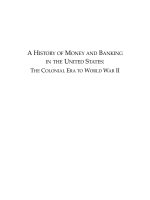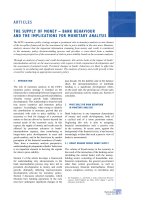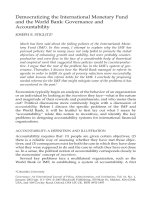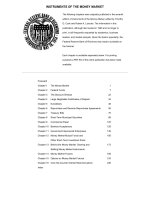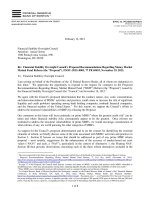Money Market Fund Regulations: The Voice of the Treasurer potx
Bạn đang xem bản rút gọn của tài liệu. Xem và tải ngay bản đầy đủ của tài liệu tại đây (2.15 MB, 64 trang )
Money Market Fund Regulations:
The Voice of the Treasurer
April 2012
© 2012 Treasury Strategies, Inc. All rights reserved.
Study Commissioned by the
Investment Company Institute
3!
Contents
Executive Letter
Overview & Participant Demographics
Findings & Conclusions
•! Floating NAV
•! Redemption Holdback
•! Loss Reserve/Capital Buffer
•! Outflow of Corporate MMF Assets
Appendix
•! Methodology
•! Investment Behavior Findings
•! Survey Instrument
•! Telephone Interview Script
•! About Treasury Strategies, Inc.
April 9, 2012
Investment Company Institute
1401 H St., NW
Suite 1200
Washington, DC 20005
Re: Proposed Regulations to Money Market Funds
Treasury Strategies, the world’s leading consulting firm in the area of treasury,
payments, and liquidity management, is pleased to present Money Market Fund
Regulations: The Voice of the Treasurer, a report sponsored by the Investment
Company Institute.
The objective of this analysis is to provide a thorough understanding of the view of
corporate treasury executives toward current money fund regulatory proposals, and
to assess their likely behaviors should any be enacted. We examined three
proposals:
• The Floating Net Asset Value (NAV)
• The Redemption Holdback
• The Loss Reserve/Capital Buffer
We surveyed 203 financial executives representing corporate, government, and
institutional investors between February 13, 2012 and March 6, 2012. The
respondents are sophisticated investors (executives with treasury and cash
management responsibilities for their institutions) with 61% of them overseeing
short-term investment pools of $100 million or more.
As detailed in the report, the reaction from this cross section of U.S. institutional
investors was overwhelmingly negative. For each of the three proposals, the
majority of treasurers surveyed indicated that if enacted, they would either
decrease or discontinue their use of money market funds. Analyses by industry and
by company size show that this sentiment is pervasive. There were no material
differences by respondent sector.
Floating Net Asset Value
If money fund NAVs were required to float:
• None of the respondents currently invested in MMFs would increase their
level of investments in money funds.
• 21% would continue using funds at the same level.
• 79% would either decrease use or discontinue altogether.
• Should this regulation be enacted, we estimate that money market fund
assets held by corporate, government and institutional investors would see
a net decrease of 61%.
Redemption Holdback
If money market funds were required to institute a 30-day holdback of 3% of all
redemptions:
• 10% of the respondents currently invested in MMFs would continue using
funds at the same level.
• 90% of respondents would either decrease their use or discontinue
altogether.
• Should this regulation be enacted, we estimate that the money market fund
assets held by corporate, government and institutional investors would see
a net decrease of 67%.
Loss Reserve/Capital Buffer
If money market funds were required to maintain a loss reserve or capital buffer:
• 8% of the respondents currently invested in MMFs would increase their
level of investments in money funds.
• 56% would continue using funds at the same level.
• 36% would either decrease their use or discontinue altogether.
However in a follow-up question, if the cost of the reserve or capital were to reduce
the yield of the fund:
• 53% of those respondents to the follow-up, who originally answered that
they would continue or increase usage, would decrease or stop usage of
MMFs if the yield were to decrease by 2bp or more (0.02%).
• 92% of those respondents to the follow-up, who originally answered that
they would continue or increase usage, would decrease or stop usage of
MMFs if the yield were to decrease by 5bp or more (0.05%).
Conclusions
On the basis of this comprehensive analysis, Treasury Strategies concludes that
corporate, government and institutional investors will respond negatively to each of
these three proposals. The overwhelming majority of treasurers will either scale
back their use of money market funds or discontinue use of them altogether.
We further conclude that corporate treasurers:
• View money market funds as an essential cash management tool
• Use them intensively
• Understand the risks, the returns and the tradeoff between the two
The clear message of our research is that should any of these proposals be
adopted, treasurers will act as one accord and simply abandon MMFs.
Respectfully,
Treasury Strategies, Inc.
Overview & Participant
Demographics
5!
Overview & Participant
Demographics
Treasury Strategies surveyed 203 unique corporate, government, and institutional investors between Feb 13,
2012 and March 6, 2012. The respondents are sophisticated investors (corporate treasury executives) with 61%
of them overseeing short-term investment pools of $100 million or more.
The executives surveyed were selected from the Treasury Strategies proprietary database of diverse financial
executives. The set of responses included both large and small corporate, institutional, and government entities,
across multiple industries. The respondents represent approximately $176.5 billion in total short-term investment
assets, and $58.5 billion in total money market fund assets.
Survey respondents were asked 31 questions concerning:
•! Their cash pools,
•! Their investment objectives, and
•! The three regulatory issues
The survey was executed through a web-based instrument, with follow-up emails conducted for points of
clarification. These were followed by phone interviews with a sample of 15 respondents. For each of the three
regulatory issues, the executives were given a short statement of the issue, followed by an argument for and an
argument against the proposal. This was to ensure balance in understanding and an objective response.
Follow-up in-depth telephone interviews both confirmed and reinforced the findings. The attached pages of
verbatim comments illustrate the intensity of the respondents’ reactions.
6!
Overview & Participant
Demographics
Treasury Strategies’ survey is comprised of 203 unique respondents. Key demographic information is detailed
below:
The largest share of respondents have annual
revenues between $1 billion-$10 billion.
All of the respondents have roles in US
treasury departments or within overseas
treasury departments that have US cash
operations.
Respondent organizational titles include the
following:
•! Chief Executive Officer
•! Chief Financial Officer
•! Treasurer
•! Assistant Treasurer
•! Treasury Manager
•! Director of Finance
203 Respondents
203 Respondents
203 Respondents
7!
Overview & Participant
Demographics
Treasury Strategies’ survey is comprised of 203 unique respondents. Participant industry distribution is shown
below.
8!
Overview & Participant
Demographics
At a high-level, the participant industry distribution is shown below. Detailed industries were grouped as follows:
Services
•! Communications/Media
•! Retail
•! Software/High-Tech
•! Business Services
•! Transportation
•! Consulting
•! Health Services
•! Other
Industrial
•! Manufacturing
•! Utilities
•! Energy & Petroleum
•! Wholesale
•! Mining
•! Construction
•! Other
Finance, Insurance, Real Estate
•! Financial Services
•! Insurance
•! Real Estate
•! Other
Not-For-Profit
•! Government
•! Higher Education
•! Not-For-Profit
•! Other
64
60
47
32
0
10
20
30
40
50
60
70
Services Industrial Finance, Insurance,
Real Estate
Not For Profit
Industry Demographics
Findings & Conclusions
•! Floating NAV
•! Redemption Holdback
•! Loss Reserve/Capital Buffer
•! Outflow of Corporate MMF
Assets
10!
Survey Question:
There is a proposal to change MMFs from a constant $1 net asset value (NAV) to a floating net asset value. Under
typical market conditions, it is anticipated that the share prices would fluctuate within a very narrow range.
Proponents say this will ensure everyone pays and receives a price that automatically reflects any gains or losses
and that it reduces the potential for runs on MMFs during adverse situations.
Opponents argue that a floating NAV would impair the use of funds as a liquidity instrument, as well as cause other
legal, accounting, tax, and market disruptions.
If the floating NAV proposal were enacted, what action would your organization most likely take?
A.! Increase use of MMFs
B.! Continue using MMFs at current level
C.! Decrease use of MMFs
D.! Stop using MMFs entirely
Findings & Conclusions
Floating NAV Proposal
11!
Findings & Conclusions
Floating NAV Proposal
If the floating NAV proposal were enacted, what action would your organization most likely take?
79% of current MMF user respondents would
either decrease or stop using MMFs, given
the enactment of the floating NAV proposal.
98% of non-MMF users would continue to
avoid investing in MMFs under the floating
NAV proposal.
136 Respondents 61 Respondents
Based on survey responses, we estimate that total corporate assets in MMFs would see a net decrease
of 61% due to this proposal.
* Responses from participants who were not currently invested in MMFs were acquired because they
may be periodic users of MMFs who are not currently invested in MMFs. Page 13 provides a detailed
breakdown of respondents.
*
12!
Findings & Conclusions
Floating NAV Proposal
If the floating NAV proposal were enacted, what action would your organization most likely take?
Of the current MMF users that responded that they would
stop or decrease use of MMFs, nearly three-fourths said
that they would decrease MMF usage by at least 50%.
136 Respondents
108 Respondents
13!
Findings & Conclusions
Floating NAV Proposal–By Segment
If the floating NAV proposal were enacted, what action would your organization most likely take?
Increase
Usage
Continue at
Current Level
Decrease
Usage
Stop Using Total
Industry*
Services 0 6 22 9 37
Industrial 0 7 16 16 39
Financial Services,
Insurance, Real Estate
0 9 11 14 34
NFP 0 6 12 8 26
Annual Revenue*
< $1B 0 10 17 18 45
$1B+ 0 18 44 29 91
Short-Term Portfolio Size*
< $250M 0 14 29 20 63
$250M + 0 14 32 27 73
Current MMF Assets*
< $75M 0 14 32 20 66
$75MM+ 0 14 29 27 70
Currently in MMF Assets* 0 28 61 47 136
Memo: Not Currently in MMFs 1 12 23 25 61
All Respondents 1 40 84 72 197
* Includes only respondents that are currently invested in MMFs
14!
67%
33%
Investment Policy, Law, or Other
Restriction for Floating NAV Instruments
No Current Restriction
Existing Investment Policy, Law, or Other Restriction
Findings & Conclusions
Floating NAV Proposal
33% of respondents indicated they have an existing investment policy, law, or other restriction that prohibits them
from investing short-term cash in a floating (fluctuating) NAV instrument.
196 Respondents
15!
Findings & Conclusions: Telephone
Interview Verbatim Responses
Floating NAV Regulation
•! “Local government investment pools by statute
have to be stable $1 NAV – so we would pull out
of MMFs if this regulation passed.”
•! "The biggest issue I have with this regulation is
the administrative pain it will cause for
accounting. When you start having more
administrative headaches, it makes you think
more about leaving it at the bank.”
•! "It's simply against our investment policy to be
invested in an instrument with a floating NAV.”
•! "This is the 5th company I’ve worked for – without
exception, if there was a floating NAV we are
done using MMFs. This is because some
companies have restrictions in their revolvers that
preclude them from investing cash in anything
that had a floating NAV. To the extent that the
company doesn't have a clause in their
investment policy, they do have a clause on
defining "cash" as the same definition in GAAP
regulations – and nothing with a floating NAV is
considered cash.”
Findings & Conclusions
•! Floating NAV
•! Redemption Holdback
•! Loss Reserve/Capital Buffer
•! Outflow of Corporate MMF
Assets
17!
Survey Question:
Another proposed idea is that each time you redeem money market fund shares, the fund would hold back part of the
redeemed amount, such as 3%. This amount would be released to you in thirty days, provided the fund maintained
its constant $1.00 NAV. If the fund did not maintain its constant $1.00 NAV during this time, any losses would be
borne first by the 3% that was held back.
Proponents say this change will make investors more cautious about redeeming shares during a period when it might
be possible the fund can no longer maintain a $1.00 share price; also that the non-refunded fees will benefit investors
that did not redeem any shares.
Opponents argue that that this defeats the liquidity feature of MMFs and will make the funds less attractive as a cash
management tool.
If regulators required money market funds to have such a redemption holdback, what action would your
organization likely take?
A.! Increase use of MMFs
B.! Continue using MMFs at current level
C.! Decrease use of MMFs
D.! Stop using MMFs entirely
Findings & Conclusions
Redemption Holdback Provision
18!
Findings & Conclusions
Redemption Holdback Provision
If regulators required money market funds to have such a redemption holdback, what action would your
organization likely take?
135 Respondents
59 Respondents
90% of current MMF users would either
decrease or stop use of MMFs given the
enactment of the holdback provision.
97% of non-MMF users would continue to
avoid investing in MMFs under the holdback
provision
Based on survey responses, we estimate that total corporate assets in MMFs would see a net decrease
of 67% due to this proposal.
*
* Responses from participants who were not currently invested in MMFs were acquired because they
may be periodic users of MMFs who are not currently invested in MMFs. Page 20 provides a detailed
breakdown of respondents.
19!
135 Respondents
Findings & Conclusions
Redemption Holdback Provision
If a redemption holdback was enacted and your organization would decrease or discontinue use of MMFs, by
how much would your investment decrease?
Of the current MMF users that responded that they would
stop or decrease use of MMFs, 81% said that they would
decrease MMF usage by at least 50%.
121 Respondents
20!
Findings & Conclusions: Redemption
Holdback Provision–By Segment
If regulators required money market funds to have such a redemption holdback, what action would your
organization likely take?
Increase
Usage
Continue at
Current Level
Decrease
Usage
Stop Using Total
Industry*
Services 0 2 18 17 37
Industrial 0 5 16 18 39
Financial Services,
Insurance, Real Estate
0 4 8 21 33
NFP 0 3 12 11 26
Annual Revenue*
< $1B 0 4 14 27 45
$1B+ 0 10 40 40 90
Short-Term Portfolio Size*
< $250M 0 7 24 31 62
$250M + 0 7 30 36 73
Current MMF Assets*
< $75M 0 5 26 34 65
$75MM+ 0 9 28 33 70
Currently in MMF Assets* 0 14 54 67 135
Memo: Not Currently in MMFs 2 9 16 32 59
All Respondents 2 23 70 99 194
* Includes only respondents that are currently invested in MMFs
21!
Findings & Conclusions
Redemption Holdback Provision
32% of respondents indicated they have an investment policy, law, or other restriction that prohibits them from
investing short-term cash in an instrument with a redemption holdback.
194 Respondents
22!
Findings & Conclusions: Telephone
Interview Verbatim Responses
Redemption Holdback Regulation
•! "That’s a nightmare in many different respects.
There are a number of accounting issues
including identifying future receivables, especially
if it’s over month-end or quarter-end. It also
means an extra line on the balance sheet. Cash
forecasting will also be more difficult as you have
different funds coming in at different times.”
•! "I have concerns over investors that are using
portals. Will the portal know to hold back the
3%?”
•! "I park my funds in MMFs overnight knowing that
my money will be there the next day. If they get to
hold onto 3 cents of my dollar for 30 days, I don't
have my money. Why not just keep it in a savings
account where at least I can get to all of it?”
•! “We have enough cash and liquidity balances
going in and out. We have flexibility enough to
deal with this – 1-2% being held back won’t be a
bother. We can plan our cash flow easily enough.
Administrative headache though.”
Findings & Conclusions
•! Floating NAV
•! Redemption Holdback
•! Loss Reserve/Capital Buffer
•! Outflow of Corporate MMF
Assets
